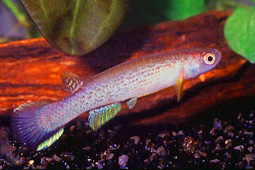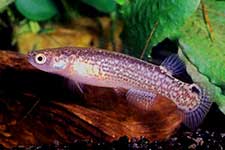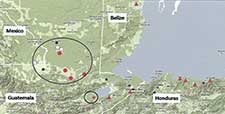History
This Rivulus degreefi is recently described and fits in the subgenus Cynodonichthys. Alternative name is Cynodonichthys degreefi. Abstract: Molecular phylogenetic analysis of samples of putative Rivulus tenuis from Mexico, Belize, Guatemala and Honduras reveals three distinct clades of taxa. One corresponds to Rivulus tenuis Meek 1904 and is distributed in lowland coastal streams from southern Mexico, Yucatan, and Belize to northwestern Honduras. Another is restricted to the Alta Verapaz region of Guatemala and adjacent areas of Mexico and corresponds to Rivulus godmani Regan 1907. The third is represented by a single collection from the Rio Oscura in the area of Guatemala bounded by mountains to the north and south and the Lago de Izabal to the east. Based upon its genetic divergence from the other populations, it is described as Rivulus degreefi sp. nov.
Reproduction
Keeping and breeding is easy but a tight fitting cover on the aquarium is necessary because their ability to jump, even through the smallest opening, is unbelievable.
This species can, if there is enough space for them, be housed in a tank with more than one male and several females. If separated before and brought together again however, they can be very aggressive towards each other and fight to become the dominant fish. The best way to produce numbers of fry is to put a pair or a trio in a small tank of about 10 litres with a small filter in it or with some aeration. On the bottom of the tank place some peat moss or dark gravel and a floating "mop" to give space for laying their eggs. The fish will, if they are fed a rich variety of live food, spawn during their whole adult life and produce daily between 5 to 15 eggs.
The eggs should be collected by hand and stored for about 14 days in a small container. Eggs are 1.6 mm and amber coloured. It is wise to add an anti fungus to the water you store the eggs in, to prevent fungal attacks.
After hatching the young fry can eat fresh artemia nauplii without any problem. It takes 4 to 5 months to raise them to maturity. Often the males far out number females. For some species this can become a major problem for the breeder, as he has to raise many fry to enable distribution of a few pairs to other hobbyists. Recent personal tests found that lower pH levels during the time of hatching gave a higher percentage of females. To achieve this I used some peat moss that I added to the container with the eggs just before they were ready to hatch. This peat moss also is a good way to prevent eggs from being attacked by fungus.
Their lifespan can be up to 3 years in captivity.
Remarks :
Variations
Map
Meristics
Max. size 0.0 cm.
Dorsal 00.0,
Anal 00.0,
D/A 0.0,
LL scale count (average) 00.0
Pre- dorsal length to % SL – 00.0 %
Depth to % SL – 00.0 %
Literature


